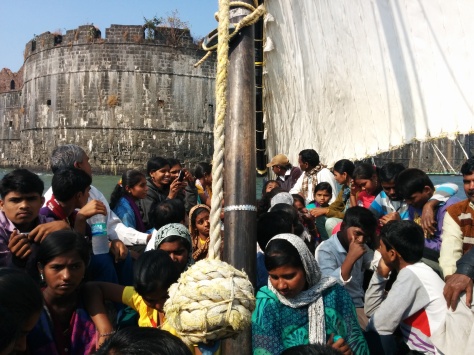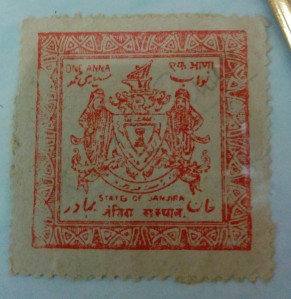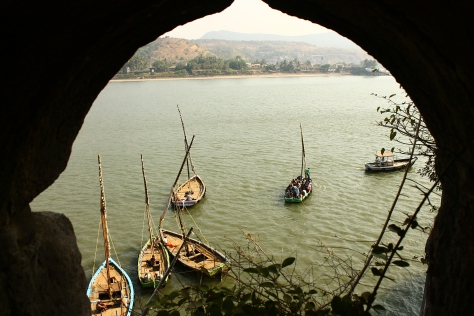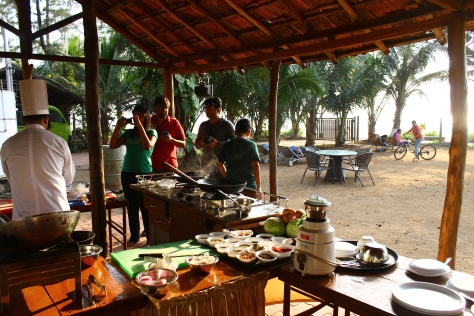He pushed a long pole into the shallow bed of the sea shore as the dighi (boat) slowly drifted into the blue-green waters of the Arabian Sea. ‘Ghai naku kara, ghai naku kara’ (Don’t hurry, don’t hurry!), the boatsman had shouted when this bunch of enthusiastic school children from a nearby village had tried to barge their way in the boat all at once, along with their ‘Sirs’. I sat right in the middle of the boat, at least seventy-eighty more people sitting in every possible direction around me. A noon sun glinted above us making the white cloth of the sail shine way beyond its cleanliness otherwise permitted.
There were no grunting Yamaha generators propelling the boat here. Only a wide sail that swerved around, veering the boat through the waters. For a while, one could hear the wind and the waves whistling to each other, the quiet harmony among the sail, the sea and the wind like a sweet unsung lullaby, a tranquiliser to the senses of almost everyone present. This peace, however, was short-lived, interrupted soon by the flutter of a mobile camera. And then it started.
Mobile phone after mobile phone being extracted from pockets, passed from hand to hand, clicked from one end of the boat to the other. As the boat neared the Janjira fort on the island in front of us, the entropy only increased. ‘Ghai naku kara, ghai naku kara’, echoed the pleas of the boatsman again, in vain, this time in the grand entrance of the fort of Janjira, as people offloaded from the boat.


Kamran, our host at the Golden Swan Beach Resort had suggested taking the Dighi rather than a steam boat to the fort from the nearby village of Janjira. And that had experience had made all the difference. As I stepped out of the boat into the fort, a realisation dawned upon me. Years, infact, centuries back, another group of sailors would have arrived here in those Arabian ‘dhows‘ that brought everything from spices to slaves with them. Inside the fort, garrulous guides, huge canons and ruins told the story of a state that had outlived attacks by all those who came in those dhows, dighis and even ships.
Five canons, each weighing tonnes, lay one after the other, un-rusted inspite of being in the middle of the sea for more than five centuries. Twenty two watch towers circled the twenty two acres over which this three-storeyed fort was built long back – approximately six hundred according to official websites and a thousand years back according to our guide. (Guides in India are always allowed some indulgence, aren’t they?) The fort of Janjira, first built by a Maratha warrior, has a curious history. The stamp collection at The Golden Swan Beach Resort displays fourteen postage stamps from the old Janjira state, each of them bearing a pre-independence era seal. January 2, 1946, 5-10-1935, 18-6-1933, go some of the seal dates. While the stamps themselves were printed in Urdu, most seals were in devnagari script.

The top line print of some of the stamps read ‘Nawab Siddi’, written in Nastaliq (Urdu) script. Unlike most other forts in Maharashtra, Janjira was not ruled by the Marathas. Instead, it was ruled by the Siddis, who came centuries back to India with the Arabs, as a part of the slave trade, according to some accounts. Though originally belonging to the Bantu tribes of east and central Africa, they are today an integral part of the society in Gujrat, Maharashtra & Karnataka states in India and even speak Indian languages.

View from the windows of the fort
One of the Siddi chiefs of the court in Aurangabad was able to retain the fort of Janjira and surrounding the area to setup an independent kingdom, with some sort of allegiance to the Mughals later on. Legend has it, that even after several attempts by the Marathas, British and the Dutch, the fort couldn’t be won back! In itself, Janjira looks like a formidable bastion. Its outer walls, their stones, haven’t given way even after years of corrosion by sea water.
In its hay days, it would have been a small civilisation in itself, with two huge ponds, one Rajwada(palace), three mosques, one temple all housed within the same complex. Our guide informed that the fort was in occupation till as late as 1970s after which the government took over, and ever since, it seems to have languished in apathy. The nearby Rajapuri village’s name not only signifies the royal association but even has a few individuals living who were born in the fort. Surnames in the village reflect the professions they were in, associated with the fort. The ruling Siddis later moved out to their palace, just at the outskirts of Murud.
While I heard the ruling prince moved to New York, the community of Siddis continue to have villages to themselves in coastal parts of India. That morning, while walking bare feet over the serene beach of Murud just behind the Resort, and overlooking the palace of the Siddis, I had wondered what a strange concoction this was- tribes from Eastern Africa, reaching India during the ages of the slave trade, speaking Indian languages, and very much a part of India’s social fabric as any other people.

Later that day I left for the jetty to Mandwa. First a taxy to Alibag, on a route that hug a beautifully clean and slightly rocky coastline to its left for several kilometres. This reminded of my coastal tuktuk rides alongside the western coast of Sri Lanka.
Then, a rickety bus trembled, jumped and rattled through the Konkan coast to Mandwa jetty. To my left and right, blackboards with typical Marathi scribbling of ‘Jewan taiyaar ahe’ in chalk kept pointing towards rustic lunch houses flanking the road. My mind wandered back to the previous day at the resort when the chef had organised a ‘Konkani’ cuisine session. I had been a little disappointed as he chose ‘okra’ (or ‘bhindi‘) for the vegetarian part of the session. Such a done and dusted dish, I had thought. (Even I knew how to make it!) But after all the cooking was done, the chef had added some ‘konkani’

masala to it and then topped it with some Khopra(coconut scrapings). A bite was enough to tell that it was a different twist to the whole okra tale as I was used to it back at my home. Slightly less cooked, which put the whole focus on the warmth of all those chillies, peppers and cinnamon that the konkani masala comprised, the khopra, more like a signature, that sealed the idea of food besides a clean Konkan beach. A little like the story of this region’s people perhaps. If only I had known then, that the Okra itself had travelled from East Africa to the west and south before reaching India, probably with the Arabs, sometime during the slave trade, the word ‘Okra’ itself derived from African terms for the vegetable. Does it sound (or should I say taste) a little similar to the story of the Siddis of ‘Janjira’, which itself is a corruption of ‘Jazeera‘ – Arabic for island??

The Cooking Session
Disclosure – I was hosted by the Golden Swan Beach Resort during my stay in Murud. The experiences, as you can already guess, are all mine.
The sundry details –
Murud-Janjira is approximately 150 kms from Mumbai. One can drive (4 hrs) or take State Transport buses from Mumbai (6 hrs). I took the catamaran from Gateway of India to Mandwa (40 mins), followed by bus to Alibag (1hr) and then another bus to Murud (2 hrs). All in all, it took me 4 hours to reach Murud from Gateway. The Golden Swan Beach Resort is on the main road for the bus, just beside the local government hospital of Murud.








